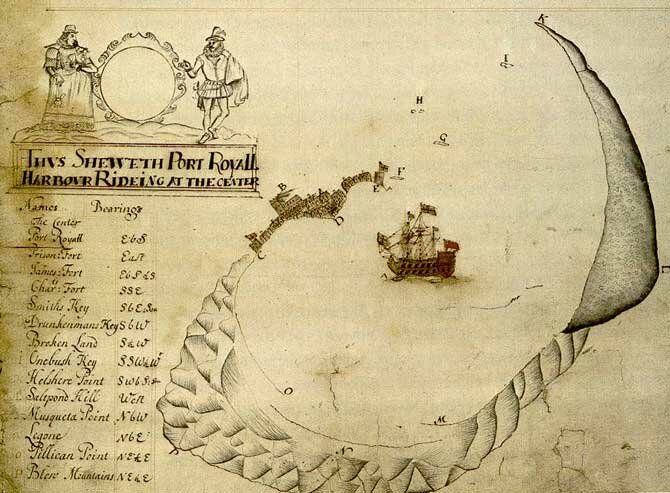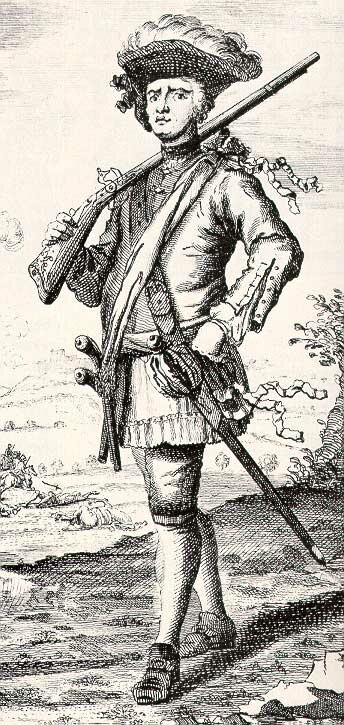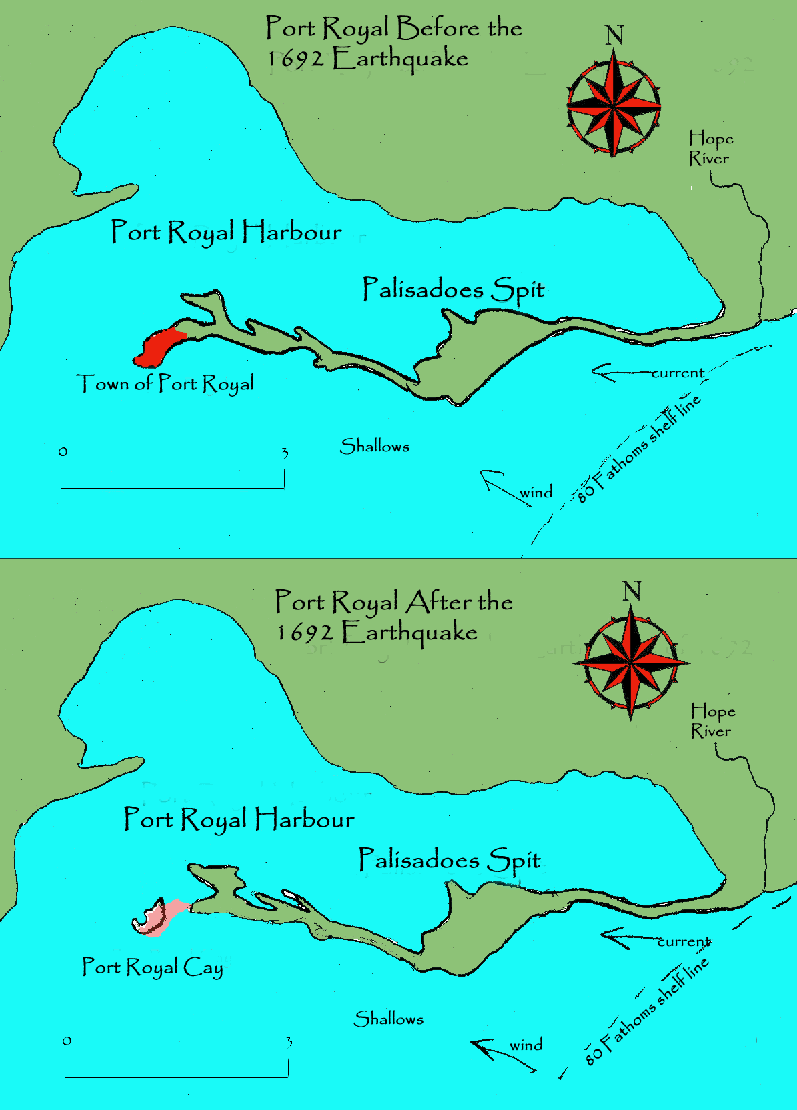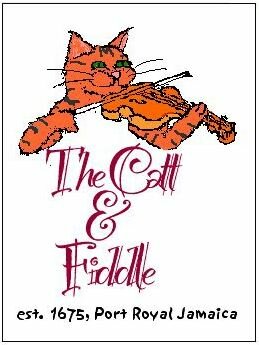Port Royal, for lack of better words, was a boom town. It was situated in just the right spot, at the right time and offered exactly what was needed. In the mid- 1600s Jamaica was a British colony surrounded by Spanish and Portuguese property. For most of this time Spain and England were at war. Port Royal was a safe protected harbor with a good draught and centrally located along the trade routes between Panama and Spain. The Buccaneers had no love for the Spaniards and were more than willing to work as Privateers for the Queen of England. Captain, Sir Henry Morgan was a Welshman who counted himself among the buccaneers.
Because of the latitude offered to buccaneers by King Charles' government, it was quite possible to make a comfortable living as a Privateer. For this reason, Buccaneers flocked to Port Royal, the de facto headquarters of raids against the Spanish Main.
As with any military operation, the camp followers also came as well as anyone else wanting to make a doubloon or two off of drunken sailors, making Port Royal not only a Privateering centering but also a den of sin and vice.

Before the British arrived in Port Royal, it was never more than a spot for fishing and carrening ships. The Arawak Indians used the Palisaoes as a transient fishing site. Later the Spaniards, saw the spot as a convenient spot to careen their ships. neither group had made any real effort at setting up permanent structures.
When the British occupied the Jamaica they realized that Port Royal may be useful place to set up a fort to discourage the Spaniards from coming into the harbour. The fort was soon established but unfortunately, their wasn't really a Navy to protect the harbour or Jamaica for that matter and the Governor of Jamaica (D 'Oyley) took it upon himself to issue Letters of Marque to raise a Private Navy or Privateers. He recruited these privateers from among the buccaneers in Tortuga and probably some of the greatest stories to ever come from the Golden age of Piracy.
The Privateers quickly found royal protection for their attacks on Spanish and Dutch ships. The town of Port Royal quickly became full of looted gold, jewels, and other products that would have been going to Spain.
The privateers would return with their plunder and quickly squander it on rumming and whoring. Within a week or two (day or two?) they would be flat broke and be off again to raid the Spanish Main on board another Privateer. It has been said that at it's zenith Port Royal had at least one tavern for every ten inhabitants and prostitutes displayed there wares openly on the street without shame or admonishment. The missionaries were present but were largely ignored. A few Churches were built but there was no one to convert and few Christians were interested in hearing a sermon.
Or so the usual story goes. In truth, the town was not as wide open as an Erroll Flynn swash-buckler made it out to be. These statistics are, as with many aspects of myths of the time, an exaggeration. At the time of the Earthquake, Port Royal's population numbered around 1,600 men, 1,400 women and perhaps 1,000 children. An estimate of 2,500 slaves has also been made. There were approximately 20 known taverns[1]. Going with just the adult male population, this would give a ratio of one tavern for every 80 people.
Of course, there were many unlisted "Inns" in Port Royal. Just about anyone who a store or house could open a tavern. Most often these tavern were nothing more than the room of a home that was set up with a table and some chairs. the Home owner would hang out a sign, and provide drink and perhaps food to customers. depending on the influx of merchants marines/privateers, just about any house in Port Royal could be an Inn for the day.
In fact some InnKeepers had two or three establishments in the same building! One room would be for upscale people and serve the best wines, brandies, and whiskeys from England to the merchants and plantation owners. Yet another room would serve locally produced beer and rum for strumpets, fishermen, and mariners.
According to Dawson & Buisseret's Port Royal Jamaica alcohol was plentiful, food was expensive, and business was lucrative. In fact, because of the influx of privateer loot, Port Royal had a thriving trade with London and the American colonies. The people wore the latest fashions from London. In exchange for the fine clothing and other manufactured goods, Port Royal sent back gold, sugar cane, and other raw materials.
As the town grew, numerous craftsmen set up shop. The town had it's own gunsmith, cooper (barrel maker), blacksmith, and even Ivory turners (jewelers who carve ivory). the port was also had numerous carpenters, cordwainers, and chuyrgeon (doctors). Naturally a large part of the population also consisted of mariners and merchants.
Of course, just as in London, their were places within the small town, where strumpets (prostitutes) plied their trade. There are even reports of prostitutes walking the streets. however they usually worked within some of the taverns in the town.
It is also said that religion was nonexistent in Port Royal but in fact the census data shows otherwise. When it came to religion the town was indeed a "wide-open" town. Just about every major religion was present in Port Royal, including, Catholicism, Judaism, Quakers, Anglicans, and Atheist. Most of the groups had fled England (except for Anglicans) during one the repressions of their religious beliefs and settled in Port Royal just as had happened in England's other American Colonies. Because most of the French Buccaneers were Catholic, the English governors were extremely tolerant of non-Anglicans. It wasn't until the usefulness of the buccaneers had passed, that wide scale persecution of non-Anglicans started taking place. Most likely, the early criticisms of the lack of religion within the town of Port Royal came from supporters of the Anglican Church.
While cheap alcohol could be brewed right on the island, most food had to be imported. This meant food tended to be expensive. Beef, pork and goat meat originally came from America or Europe. the animals were brought in live. Even the fish and turtle meat was expensive. Their was no way to keep the meat fresh, so all the animals were kept live and slaughtered on the day they were used.
The town inhabitants also did not trust the local fresh water sources. It was quite common for new comers to Port Royal to come down with the "flux" or the "gripes". (Dysentery or what was probably lead poisoning) both diseases were blamed on the water. The gripes were more likely caused by the rum which was often distilled using lead pipes. Despite the initial sicknesses suffered by newcomers, Port Royal was a relatively healthy place to live, compared to other cities in America and Europe.
After the sack of Panama, and Morgan's arrest and eventual appointment as Lieutenant Governor things began to change. The slave trade had been in practice for several years already, but now that the War with Spain was resolved for the time being, it became more important to Port Royal. The plantation owners of Jamaica were seeing much better profits from their cheap slave labor and looked down on Port Royal as an eyesore. Many of the buccaneers continued to ply their trade only to wind up swinging in chains at Gallows's point, their death warrant signed by Morgan himself.
Henry Morgan

The plantation owners, and many of the merchants within Port Royal were cut from a the more civilized gentry who disdained the whoring and debauching of the transient Privateers/buccaneers and were busily working on changing the town. It's hard to look back from the present and not see the irony of the situation. Whoring and debauching were considered immoral but getting rich by enslaving and working people to death was considered an honest form of commerce. However, we should not judge the past with our viewpoints, only learn from it!
Of course, the way many sailors saw it, it was still better to risk hanging for a fortune than to work plantations. With that in mind, the pirate's life was still chosen by many. Whoring was still one of the few ways that a woman could make a living on her own, and rum could always be sold, if not to pirates then to the slave ships. There was little the plantation owners could do to change the transient nature of Port Royal.
Read more information about Henry Morgan by the link.
On August 25, 1688 Tuberculosis did what the plantation owners couldn't do sir Henry Morgan at the age of 53 died. He was buried on the Palisadoes spit. and Port Royal followed violently behind him. Four years later, on June 7, 1692 the earth began to tremble and when it was over the old port, along with Morgan's grave returned to the Sea.
The Earthquake of 1692
The Earthquake of 1692 was just one of many natural disasters to hit Port Royal. A hurricane in 1655 had actually separated the town form the rest of Jamaica as well. In order to get a feel for what happened with the Earthquake in 1692, you need to get a feel for the geology of Port Royal.

Port Royal, the harbour, and the earthquake. Click to enlarge
Port Royal is basically the last cay in a line of connected cays extending from the mouth of the Hope River.
Because of South Easterly wind and Western ocean current, sediments from the Hope River were deposited along the ocean floor extending westward from the mouth of the river. Over time, a series of cays or small islands formed as coral reefs began to grow in the rich sediments deposited by the river. These cays continued to collect more and more sediment until the Palisadoes Spit formed.
On a side note, the hurricane of 1655 washed away portions of the top sand and separated Port Royal from the rest of the Island, the english sunk old ships and dumped in rock and sand to rebuild the spit and reattach the town to the rest of Jamaica.
Unfortunately for the Palisadoes spit, the land is unstable. basically there is a bed of limestone (made from the old coral reef) and then a layer of loose sand on top of the limestone. this loose sand often becomes saturated with water which allows it to easily slip from side to side. To make matters worse, the ocean shelf is less than five miles from Port Royal. This ocean shelf is the site for possible earthquakes.
This brings us to June 7, 1692. On that morning, the ground at first began to tremble. From eyewitness accounts, the ground never shook, it actually began to move as if it were "waves on the ocean" According to some accounts, the ground turned to water right under their feet, and people sank into the water. Others say the ground opened up into vast pools of water. Most likely the sand had become so saturated with ocean water that it could no longer support any kind of weight and people and objects did actually sink into the water. Just as quickly, the water rushed out and what was left were people half buried in the ground.
The entire Western end of the town then slid into the ocean. What has been speculated is the solid limestone foundation was pushed upwards by the earthquake. This caused the loose sand which had been saturated with ocean water, to slide to the sides rather that just break open. The older wooden structures built by the Spaniards faired better against the quake than the newer stone and brick structures. This was because the wood was more flexible and was more likely to shake than break.
Almost immediately after the quake, a tidal wave hit the town. Many of the people who had been half buried by the quake were drowned by this tidal wave. Within a few minutes over two thousand people died. To make matters worse, the cemetery located outside of town on the Palisadoes was opened up by the quake and most of it slid into the sea as well.
For the next several weeks, people were recovering bodies from the town and the cemetery. To complicate the recovery, looters ran free throughout the town. Several ships had been lost or damaged in the harbor. Of course the biggest problem was Port Royal had become a cay. The ocean had reclaimed the Palisadoes Spit from just east of Fort Rupert or Morgan's Line making it difficult for the rest of Jamaica to assist the town.
The few survivors rebuilt on the site but most of Jamaica preferred building in Kingston, across the bay. In 1735 a naval base was established once more at Port Royal for the British West Indies Squadron in its struggle against the French.
Today Port Royal is a quiet little town, with only a few relics of its romantic past: Fort Charles at the entrance to the harbour once under the command of Horatio Nelson, St. Peter's Church, and a museum displaying some treasures resurrected from the sea. Pop. (1982) 1,469.
The Taverns of Port Royal: Before the Earthquake of 1692
The dates below reflect known entries in official records. It is quite possible that the taverns were in business both before and after the dates mentioned. The image below is pure conjecture based on similar signs used by "Cat and Fiddle" inns known to exist throughout English colonies from the 1600's to the present.

- The Black Dogg, 1692
- The Blue Anchor, 1679
- The Catt and Fiddle, 1676
- The Cheshire Cheese, 1684
- The Feathers, 1681
- The Green Dragon, 1674
- The Jamaican Arms, 1677
- The King's Arm, (no. 1) 1677
- The King's Arm, (no. 2) 1677
- The Salutacon, 1680
- The Shipp, 1674
- The Sign of Bacchus, 1673
- The Sign of the Mermaid, 1685
- The Sign of the George, 1682
- The Sugar Loaf, 1667
- The Three Crowns, 1673
- The Three Mariners, 1677
- The Three Tunns, 1665
- The Windmill, 1684

The only author and editor of all pages on the site. Most of what I write about is based on years of book reading on the topic. My first web page was published back in 1994.